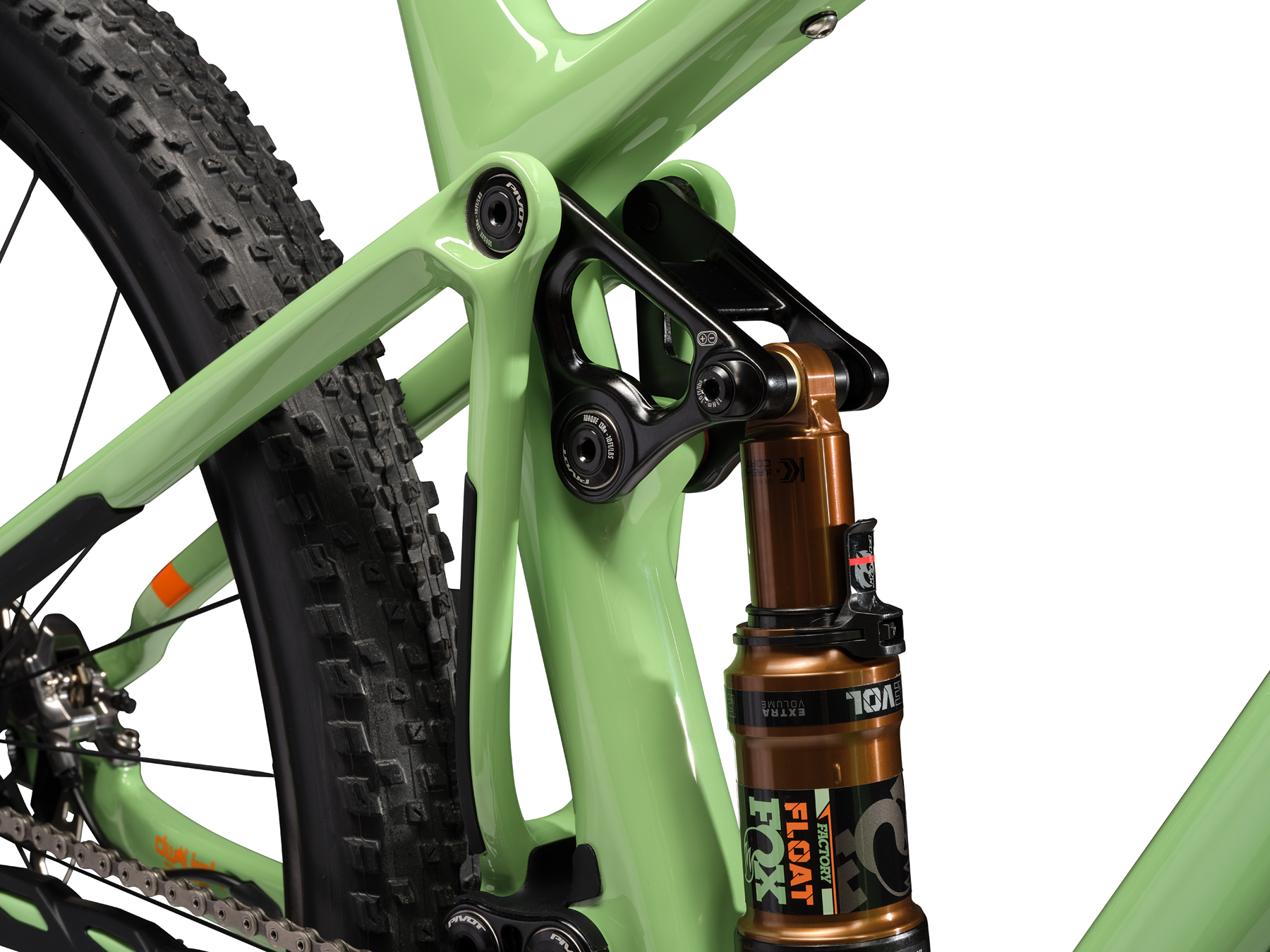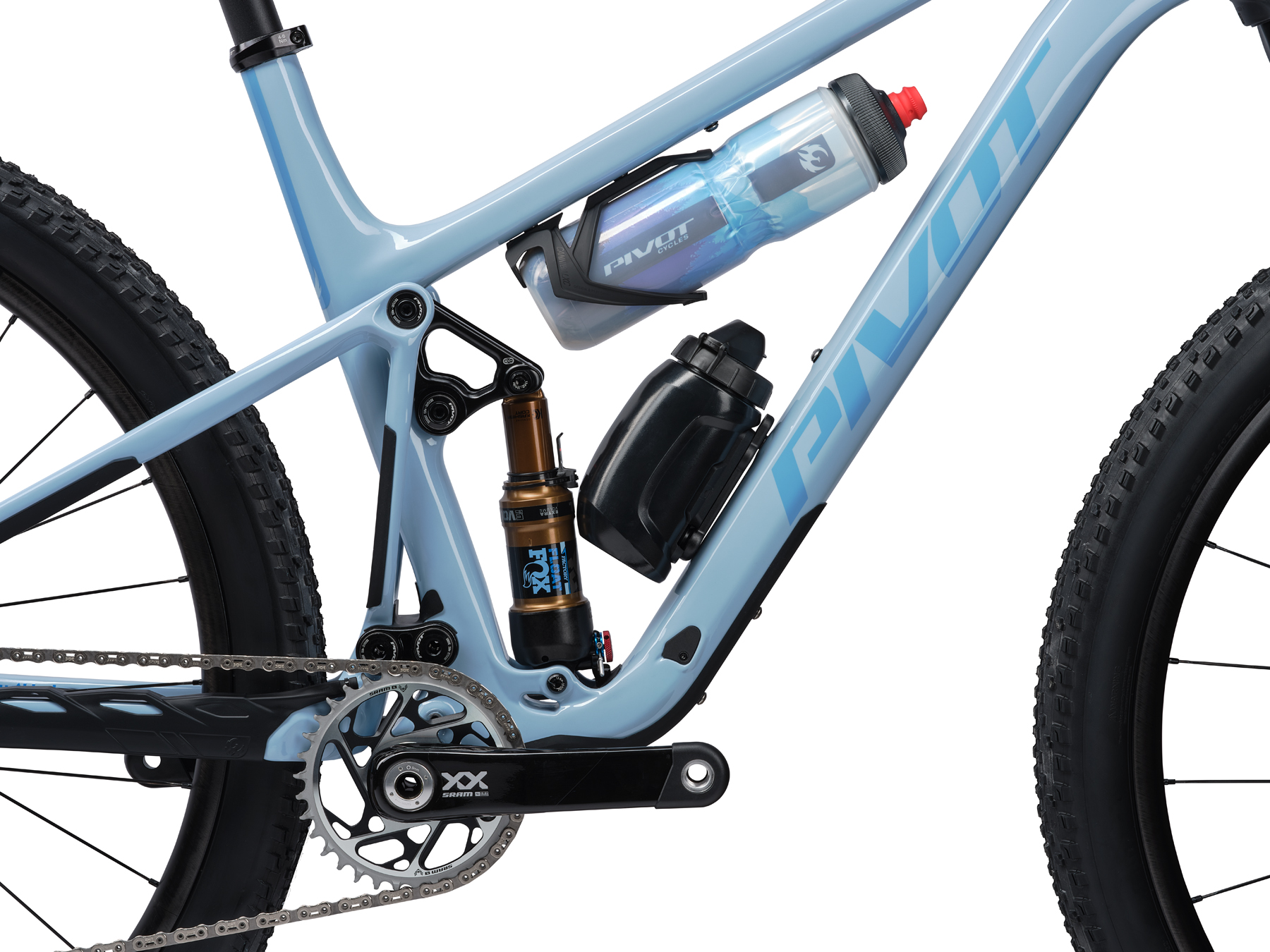Pivot Mach 4 SL V3
Wheel Size: 29’’
Travel:
- 95 or 103 mm rear / 100 mm front (World Cup builds)
- 106 or 115 mm rear / 120 mm front (Team, Pro, and Ride builds)
Geometry highlights:
- Sizes offered: XS, S, M, L, XL
- Headtube angle: 68° (100 mm fork) / 66.7° (120 mm fork)
- Seat tube angle: 76° (100 mm fork) / 74.7° (120 mm fork)
- Reach: 450 mm (size Medium)
- Chainstay length: 432 mm
Frame material: Carbon fiber
Stated weight:
- Frame only: 1,660 g (size Small, w/o shock)
- Frame & shock: 1,930 g (size Small, with Fox DPS)
- Complete bike: 23.0 lb / 10.4 kg (Mach 4 SL XX World Cup, size Small)
Price: Complete bikes: $6,199 to $11,599

Intro
Pivot’s shortest-travel, most XC-focused full-suspension bike, the Mach 4 SL, has been in their lineup for a while now, and Pivot has long offered a range of builds with decidedly different fork sizes and a range of other tweaks, meant to cover both true XC race duty and to cater to folks who want more of a super light short-travel Trail bike. While the new iteration of the Mach 4 SL doesn’t look all that different from its predecessor, the new bike gets a lot of interesting refinements, including a substantial drop in frame weight, some geometry updates, and more adjustability to better cover the range of use cases that Pivot has set out for it.
And while Pivot is clearly positioning the Mach 4 SL to be a World-Cup-ready XC race bike, they’re also talking about things like “fun” in their copy for the new bike. So, what exactly is it?
The Frame
The new third-generation Mach 4 SL doesn’t stray too far from its predecessor in terms of the high-level details. It’s still a DW-link bike with a vertically oriented shock, 29’’ wheels, and a carbon fiber frame only. Somewhat unusually, the Mach 4 SL is offered in builds with both 100 and 120mm-travel forks (more on those below), a feature that carries over from the prior iteration. But while that bike came with 100 mm of rear-wheel travel regardless, the new Mach 4 SL uses different shock strokes to bump up the travel on the versions spec’d with a 120mm-travel fork, and also adds a travel-adjusting flip chip to the upper shock mount. On the shorter-travel World Cup builds, that produces either 95 or 103 mm of rear wheel travel by way of a 190 x 40 mm shock; the rest of the range stretches the shock stroke to 45 mm, which results in 106 or 115 mm of travel, depending on the flip chip orientation.



Fit & Geometry
Pivot offers the Mach 4 SL in five sizes, XS through XL, and while they’ve given the new bike a little bit of the classic longer / slacker treatment, the changes are, at least on paper, much more minor tweaks than a dramatic overhaul. The headtube angle has been relaxed by 0.5° to 68°, the seat tube angle steepened to 76°, and the reach lengthened by between 5 and 15 mm depending on the size in question; the Medium Mach 4 SL now clocks in at 450 mm, and the Large measures 475 mm. The full reach range runs from 410 mm on the XS through 495 mm on the XL, with the Small rounding things off at 425 mm. While Pivot has been adopting size-specific chainstay lengths on some of their longer-travel bikes, the Mach 4 SL gets 432 mm ones across the board.
The geometry of course also changes quite a bit depending on the spec’d fork length — a 20 mm swing in fork travel is a substantial one. The numbers stated above are with the shorter 100 mm fork that comes on the World Cup builds; swapping to a 120mm-travel fork slackens the headtube to 66.7° and seat tube angle to 74.7°, raises the bottom bracket by about 9 mm (to 36 mm of drop) and lops 13 mm off the reach in a given size.
The Builds
As per usual for Pivot, the Mach 4 SL is offered in a wide range of mid-to-high-end builds, with options for SRAM and Shimano drivetrains (including SRAM’s new T-Type groupsets) but with Fox suspension across the board.


- Drivetrain: Shimano SLX w/ XT rear derailleur
- Crankset: Race Face Ride
- Brakes: Shimano SLX 2-piston w/ 160 mm rotors
- Fork: Fox 34 Stepcast Performance (120 mm travel)
- Shock: Fox Float Performance
- Wheels: DT Swiss X1900
- Dropper Post: Fox Transfer Performance Elite (XS–S: 125 mm; M–L: 150 mm; XL: 175 mm)
- Drivetrain: SRAM GX w/ X01 rear derailleur
- Crankset: SRAM Descendant 7K
- Brakes: SRAM Level TL 4-piston w/ 160 mm rotors
- Fork: Fox 34 Stepcast Performance (120 mm travel)
- Shock: Fox Float Performance
- Wheels: DT Swiss X1900
- Dropper Post: Fox Transfer Performance Elite (XS–S: 125 mm; M–L: 150 mm; XL: 175 mm)
- Drivetrain: Shimano XT w/ XTR rear derailleur
- Crankset: Race Face Æffect R
- Brakes: Shimano XT 2-piston w/ 160 mm rotors
- Fork: Fox 34 Stepcast Factory (120 mm travel)
- Shock: Fox Float Factory w/ SRAM TwistLoc remote
- Wheels: DT Swiss XR1700
- Reynolds Blacklabel 308/289 XC w/ Industry Nine Hydra hubs available for $1,200 upcharge
- Dropper Post: Fox Transfer Factory (XS–S: 125 mm; M–L: 150 mm; XL: 175 mm)
- Drivetrain: SRAM X0 Transmission
- Crankset: SRAM X0 T-Type
- Brakes: SRAM Level Silver Stealth 2-piston w/ 160 mm rotors
- Fork: Fox 34 Stepcast Factory (120 mm travel)
- Shock: Fox Float Factory w/ SRAM TwistLoc remote
- Wheels: DT Swiss XR1700
- Reynolds Blacklabel 308/289 XC w/ Industry Nine Hydra hubs available for $1,200 upcharge
- Dropper Post: Fox Transfer Factory (XS–S: 125 mm; M–L: 150 mm; XL: 175 mm)
- Drivetrain: Shimano XTR
- Crankset: Race Face Next SL
- Brakes: Shimano XTR 2-piston w/ 160 mm rotors
- Fork: Fox 34 Stepcast Factory (120 mm travel)
- Shock: Fox Float Factory w/ SRAM TwistLoc remote
- Wheels: Reynolds Blacklabel 308/289 XC w/ Industry Nine Hydra hubs
- Dropper Post: Fox Transfer Factory (XS–S: 125 mm; M–L: 150 mm; XL: 175 mm)
- Drivetrain: SRAM XX SL Transmission
- Crankset: SRAM XX SL T-Type
- Brakes: SRAM Level Ultimate Stealth 2-piston w/ 160 mm rotors
- Fork: Fox 34 Stepcast Factory (120 mm travel)
- Shock: Fox Float Factory w/ SRAM TwistLoc remote
- Wheels: Reynolds Blacklabel 308/289 XC w/ Industry Nine Hydra hubs
- Dropper Post: RockShox Reverb AXS (XS: 100 mm; S–L: 125 mm; XL: 150 mm)
- Drivetrain: Shimano XTR
- Crankset: Race Face Next SL
- Brakes: Shimano XTR 2-piston w/ 160 mm rotors
- Fork: Fox 32 Stepcast Factory w/ SRAM TwistLoc remote (100 mm travel)
- Shock: Fox Float DPS Factory w/ SRAM TwistLoc remote
- Wheels: Reynolds Blacklabel 308/289 XC w/ Industry Nine Hydra hubs
- Dropper Post: Fox Transfer SL Factory (100 mm)
- Drivetrain: SRAM XX SL Transmission
- Crankset: SRAM XX SL T-Type
- Brakes: SRAM Level Ultimate Stealth 2-piston w/ 160 mm rotors
- Fork: Fox 32 Stepcast Factory w/ SRAM TwistLoc remote (100 mm travel)
- Shock: Fox Float DPS Factory w/ SRAM TwistLoc remote
- Wheels: Reynolds Blacklabel 308/289 XC w/ Industry Nine Hydra hubs
- Dropper Post: Fox Transfer SL Factory (100 mm)
Some Questions / Things We’re Curious About
(1) The Mach 4 SL World Cup builds seem to be straightforwardly aimed at true XC race duty, but what sorts of riders are going to be best suited for the Ride, Pro, and Team options, with more suspension travel, slightly burlier parts, and substantially different geometry?
(2) Does offering the Mach 4 SL with such a wide range of fork lengths feel like it introduces any particular quirks, or do both configurations feel fairly dialed?
Bottom Line (For Now)
Pivot appears to have given the Mach 4 SL a sensible set of updates — pared-down frame weight, SRAM Transmission compatibility, tweaked geometry, and so on — without reshaping it into a radically different bike than the prior iteration. And offering their XC race bike with a range of build options that span more than just hardcore race duty is a neat idea that Pivot seems to have had some success with on the prior-generation bike.


I’m taking delivery of MY new Mach 4 SL next week! I’ll send in a review after a couple weeks. My intended use is trail riding; In my area; Jackson Hole & Teton Valley ,ID., that means a lot of well made trails & also old -school tracks that involve the usual gamut of S#*% and pushing!!
What’s not to like about a proven platform that’s lighter & has the UDH? I don’t understand why you consider a 20mm range in fork travel “such a wide range of fork lengths.”
As always the proof is in the riding. PIVOT is no Johnny Come Lately & unless (or even if) you’re toeing the WC start line the “long in the tooth” single pivot/flex stay design is dated & has reached the end of its evolution.
The “Belly Tank” position for anything, on a rig used for anything, save bike packing, is comical. That’s why we have that burly armor down there, Hahaha. Cheers, keep up the good work
The 429 was the bike I wanted until I saw they’re super boost. Looking around I considered the Ranger & the Spur until I found a Tallboy frame on sale.
The week I finished the build, Pivot releases the new Mach 4 so now I’m left hanging, but the cost of the Tallboy build was still about the same as a Mach 4 frame